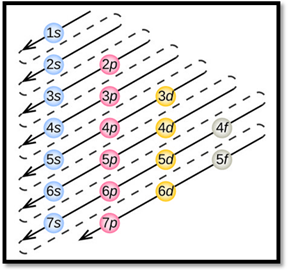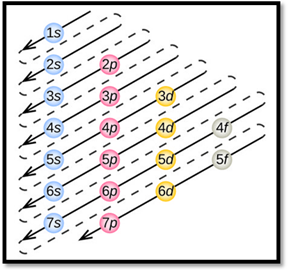
General Chemistry: Atoms First
2nd Edition
ISBN: 9780321809261
Author: John E. McMurry, Robert C. Fay
Publisher: Prentice Hall
expand_more
expand_more
format_list_bulleted
Concept explainers
Question
Chapter 3, Problem 3.55SP
(a)
Interpretation Introduction
Interpretation:
From
Concept introduction:
By using aufbau principle, electrons starts to occupy from orbitals oflower energy level. Thus, the obtained lower energy configuration is known as ground-state electron configuration.
Aufbau principle:
- Electrons first occupy orbitals with lower energy than higher energy.
- An orbital can be occupied only by two electrons having opposite spins.
- Each electron fills each orbital till it is half filled, when they are degenerate orbital. This is called as Hund’s rule.
- The order of electrons filling in an atom is given as

Figure 1
(b)
Interpretation Introduction
Interpretation:
From the
Concept introduction:
By using aufbau principle, electrons starts to occupy from orbitals of lower energy level. Thus, the obtained lower energy configuration is known as ground-state electron configuration.
Aufbau principle:
- Electrons first occupy orbitals with lower energy than higher energy.
- An orbital can be occupied only by two electrons having opposite spins.
- Each electron fills each orbital till it is half filled, when they are degenerate orbital. This is called as Hund’s rule.
- The order of electrons filling in an atom is given as

Figure 1
Expert Solution & Answer
Want to see the full answer?
Check out a sample textbook solution
Students have asked these similar questions
Can the target compound at right be efficiently synthesized in good yield from the unsubstituted benzene at left?
?
starting
material
target
If so, draw a synthesis below. If no synthesis using reagents ALEKS recognizes is possible, check the box under the drawing area.
Be sure you follow the standard ALEKS rules for submitting syntheses.
+ More...
Note for advanced students: you may assume that you are using a large excess of benzene as your starting material.
C
:0
T
Add/Remove step
G
The following equations represent the formation of compound MX. What is the AH for the
electron affinity of X (g)?
X₂ (g) → 2X (g)
M (s) → M (g)
M (g)
M (g) + e-
AH = 60 kJ/mol
AH = 22 kJ/mol
X (g) + e-X (g)
M* (g) +X (g) → MX (s)
AH = 118 kJ/mol
AH = ?
AH = -190 kJ/mol
AH = -100 kJ/mol
a)
-80 kJ
b)
-30 kJ
c)
-20 kJ
d)
20 kJ
e)
156 kJ
A covalent bond is the result of the
a)
b)
c)
d)
e)
overlap of two half-filled s orbitals
overlap of a half-filled s orbital and a half-filled p orbital
overlap of two half-filled p orbitals along their axes
parallel overlap of two half-filled parallel p orbitals
all of the above
Chapter 3 Solutions
General Chemistry: Atoms First
Ch. 3.1 - Prob. 3.1PCh. 3.1 - Which of the following drawings is most likely to...Ch. 3.2 - Give systematic names for the following compounds:...Ch. 3.2 - Write formulas for the following compounds: (a)...Ch. 3.2 - Prob. 3.5CPCh. 3.2 - Give systematic names for the following compounds:...Ch. 3.2 - Prob. 3.7PCh. 3.2 - Prob. 3.8CPCh. 3.3 - Predict the ground-state electron configuration...Ch. 3.3 - What doubly positive ion has the following...
Ch. 3.4 - Prob. 3.11PCh. 3.4 - which of the following spheres represents a K+...Ch. 3.5 - Using the periodic table as your guide, predict...Ch. 3.6 - (a) Which has the larger third ionization energy,...Ch. 3.6 - Three atoms have the following electron...Ch. 3.6 - Order the indicated three elements according to...Ch. 3.7 - Prob. 3.17PCh. 3.7 - Which of the indicated three elements has the...Ch. 3.8 - What noble-gas configurations are the following...Ch. 3.8 - Prob. 3.20PCh. 3.9 - Calculate the net energy change in kilojoules per...Ch. 3.10 - Which substance in each of the following pairs has...Ch. 3.10 - One of the following pictures represents NaCl and...Ch. 3.11 - Prob. 3.24PCh. 3.11 - Complete the following equations so that the same...Ch. 3.12 - Prob. 3.26PCh. 3.12 - Prob. 3.27PCh. 3.14 - Prob. 3.28PCh. 3 - In the following drawings, red spheres represent...Ch. 3 - Which of the following drawings is more likely to...Ch. 3 - Prob. 3.31CPCh. 3 - Prob. 3.32CPCh. 3 - Prob. 3.33CPCh. 3 - Prob. 3.34CPCh. 3 - Prob. 3.35CPCh. 3 - Prob. 3.36CPCh. 3 - Prob. 3.37CPCh. 3 - Prob. 3.38SPCh. 3 - Prob. 3.39SPCh. 3 - Prob. 3.40SPCh. 3 - Prob. 3.41SPCh. 3 - Prob. 3.42SPCh. 3 - Prob. 3.43SPCh. 3 - Prob. 3.44SPCh. 3 - Prob. 3.45SPCh. 3 - Prob. 3.46SPCh. 3 - Prob. 3.47SPCh. 3 - Prob. 3.48SPCh. 3 - Prob. 3.49SPCh. 3 - Prob. 3.50SPCh. 3 - Prob. 3.51SPCh. 3 - Prob. 3.52SPCh. 3 - What is the identity of the element X in the...Ch. 3 - Prob. 3.54SPCh. 3 - Prob. 3.55SPCh. 3 - Prob. 3.56SPCh. 3 - Prob. 3.57SPCh. 3 - Prob. 3.58SPCh. 3 - Prob. 3.59SPCh. 3 - Prob. 3.60SPCh. 3 - Prob. 3.61SPCh. 3 - Prob. 3.62SPCh. 3 - Prob. 3.63SPCh. 3 - Prob. 3.64SPCh. 3 - Prob. 3.65SPCh. 3 - Prob. 3.66SPCh. 3 - Prob. 3.67SPCh. 3 - Which element in each of the following sets has...Ch. 3 - Prob. 3.69SPCh. 3 - Prob. 3.70SPCh. 3 - Prob. 3.71SPCh. 3 - Prob. 3.72SPCh. 3 - Prob. 3.73SPCh. 3 - Prob. 3.74SPCh. 3 - Prob. 3.75SPCh. 3 - Prob. 3.76SPCh. 3 - Prob. 3.77SPCh. 3 - Prob. 3.78SPCh. 3 - Order the following compounds according to their...Ch. 3 - Calculate the energy change in kilojoules per mole...Ch. 3 - Prob. 3.81SPCh. 3 - Prob. 3.82SPCh. 3 - Prob. 3.83SPCh. 3 - Prob. 3.84SPCh. 3 - Prob. 3.85SPCh. 3 - Calculate the overall energy change in kilojoules...Ch. 3 - The estimated lattice energy for CsF2(s) is +2347...Ch. 3 - Prob. 3.88SPCh. 3 - Prob. 3.89SPCh. 3 - Prob. 3.90SPCh. 3 - Prob. 3.91SPCh. 3 - Prob. 3.92SPCh. 3 - Prob. 3.93SPCh. 3 - Prob. 3.94SPCh. 3 - Prob. 3.95SPCh. 3 - Prob. 3.96SPCh. 3 - Prob. 3.97SPCh. 3 - Prob. 3.98SPCh. 3 - Prob. 3.99SPCh. 3 - Prob. 3.100CHPCh. 3 - Prob. 3.101CHPCh. 3 - Prob. 3.102CHPCh. 3 - Prob. 3.103CHPCh. 3 - Prob. 3.104CHPCh. 3 - Prob. 3.105CHPCh. 3 - Prob. 3.106CHPCh. 3 - Prob. 3.107CHPCh. 3 - Prob. 3.108CHPCh. 3 - Prob. 3.109CHPCh. 3 - Prob. 3.110CHPCh. 3 - Prob. 3.111CHPCh. 3 - Prob. 3.112CHPCh. 3 - Prob. 3.113CHPCh. 3 - Prob. 3.114CHPCh. 3 - Given the following information, construct a...Ch. 3 - Given the following information, construct a...Ch. 3 - Consider the electronic structure of the element...Ch. 3 - Prob. 3.118MPCh. 3 - Prob. 3.119MP
Knowledge Booster
Learn more about
Need a deep-dive on the concept behind this application? Look no further. Learn more about this topic, chemistry and related others by exploring similar questions and additional content below.Similar questions
- Can the target compound at right be efficiently synthesized in good yield from the unsubstituted benzene at left? starting material target If so, draw a synthesis below. If no synthesis using reagents ALEKS recognizes is possible, check the box under the drawing area. Be sure you follow the standard ALEKS rules for submitting syntheses. + More... Note for advanced students: you may assume that you are using a large excess of benzene as your starting material. C T Add/Remove step X ноarrow_forwardWhich one of the following atoms should have the largest electron affinity? a) b) c) d) 으으 e) 1s² 2s² 2p6 3s¹ 1s² 2s² 2p5 1s² 2s² 2p 3s² 3p² 1s² 2s 2p 3s² 3p6 4s2 3ds 1s² 2s² 2p6arrow_forwardAll of the following are allowed energy levels except _. a) 3f b) 1s c) 3d d) 5p e) 6sarrow_forward
- A student wants to make the following product in good yield from a single transformation step, starting from benzene. Add any organic reagents the student is missing on the left-hand side of the arrow, and any addition reagents that are necessary above or below the arrow. If this product can't be made in good yield with a single transformation step, check the box below the drawing area. Note for advanced students: you may assume that an excess of benzene is used as part of the reaction conditions. : ☐ + I X This product can't be made in a single transformation step.arrow_forwardPredict the major products of this organic reaction:arrow_forwardCalculate the density of 21.12 g of an object that displaces 0.0250 L of water.arrow_forward
- Draw the expected reactant R28. Cu(II) CO₂Mearrow_forwardPpplllleeeaaasssseeee helllppp wiithhh thisss Organic chemistryyyyyy I talked like this because AI is very annoyingarrow_forwardName the family to which each organic compound belongs. The first answer has been filled in for you. compound CH₂ || CH3-C-NH2 0 ။ CH3-C-CH₂ CH=O–CH=CH, CH₂ HO CH2-CH2-CH-CH3 family amine Darrow_forward
- 1b. Br LOHarrow_forwardI would like my graphs checked please. Do they look right? Do I have iodine and persulfate on the right axis ?arrow_forwardReaction Fill-ins Part 2! Predict the product(s) OR starting material of the following reactions. Remember, Hydride shifts are possible if/when a more stable carbocation can exist (depending on reaction mechanism)! Put your answers in the indicated boxes d. d. ง HCIarrow_forward
arrow_back_ios
SEE MORE QUESTIONS
arrow_forward_ios
Recommended textbooks for you
 Chemistry: The Molecular ScienceChemistryISBN:9781285199047Author:John W. Moore, Conrad L. StanitskiPublisher:Cengage Learning
Chemistry: The Molecular ScienceChemistryISBN:9781285199047Author:John W. Moore, Conrad L. StanitskiPublisher:Cengage Learning Chemistry: Principles and PracticeChemistryISBN:9780534420123Author:Daniel L. Reger, Scott R. Goode, David W. Ball, Edward MercerPublisher:Cengage Learning
Chemistry: Principles and PracticeChemistryISBN:9780534420123Author:Daniel L. Reger, Scott R. Goode, David W. Ball, Edward MercerPublisher:Cengage Learning Principles of Modern ChemistryChemistryISBN:9781305079113Author:David W. Oxtoby, H. Pat Gillis, Laurie J. ButlerPublisher:Cengage Learning
Principles of Modern ChemistryChemistryISBN:9781305079113Author:David W. Oxtoby, H. Pat Gillis, Laurie J. ButlerPublisher:Cengage Learning Physical ChemistryChemistryISBN:9781133958437Author:Ball, David W. (david Warren), BAER, TomasPublisher:Wadsworth Cengage Learning,
Physical ChemistryChemistryISBN:9781133958437Author:Ball, David W. (david Warren), BAER, TomasPublisher:Wadsworth Cengage Learning,

Chemistry: The Molecular Science
Chemistry
ISBN:9781285199047
Author:John W. Moore, Conrad L. Stanitski
Publisher:Cengage Learning

Chemistry: Principles and Practice
Chemistry
ISBN:9780534420123
Author:Daniel L. Reger, Scott R. Goode, David W. Ball, Edward Mercer
Publisher:Cengage Learning

Principles of Modern Chemistry
Chemistry
ISBN:9781305079113
Author:David W. Oxtoby, H. Pat Gillis, Laurie J. Butler
Publisher:Cengage Learning

Physical Chemistry
Chemistry
ISBN:9781133958437
Author:Ball, David W. (david Warren), BAER, Tomas
Publisher:Wadsworth Cengage Learning,
The Bohr Model of the atom and Atomic Emission Spectra: Atomic Structure tutorial | Crash Chemistry; Author: Crash Chemistry Academy;https://www.youtube.com/watch?v=apuWi_Fbtys;License: Standard YouTube License, CC-BY